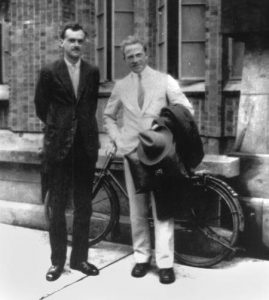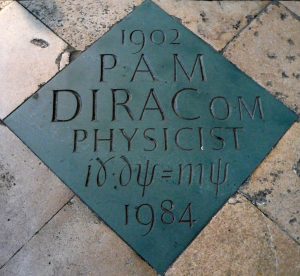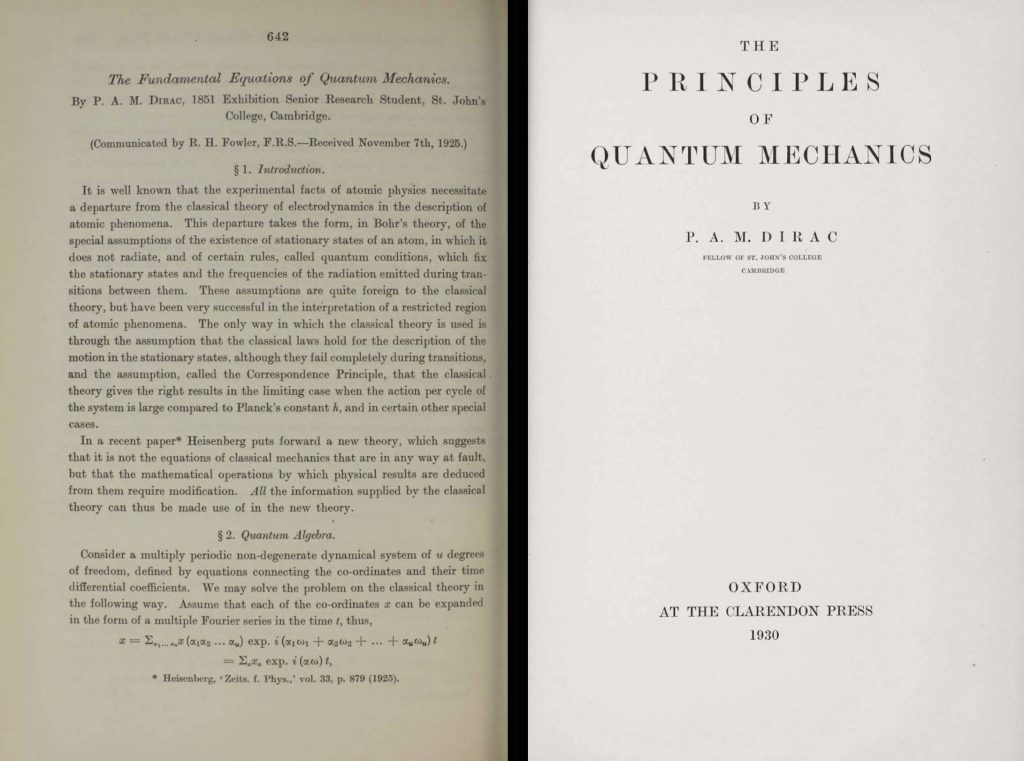One of the great protagonists in the creation of what we now call Quantum Mechanics was undoubtedly the Englishman Paul A.M. Dirac. He was born in Bristol in 1902 to a Swiss father –who earned his living as a French teacher– and an English mother. His childhood was not exactly a happy one, which marked him for life and made him a tremendously shy and introverted person. He told the story himself in 1962:
In fact, I had no social life at all when I was a child… My father imposed a rule on me that I could only speak to him in French. He thought it would be good for me to learn French that way. I found that I couldn’t express myself in French, and that it was better for me to be silent than to speak English. So I became very silent from that moment on.
The lonely Dirac, unable to interact with his environment, found in the study of physics and especially mathematics a way to escape his dreary life. In fact, the school where Dirac studied hardly encouraged any subjects other than scientific and practical ones, something for which Dirac was grateful. He entered university at a very young age and graduated as an electrical engineer (a decision his tyrannical father made and imposed on his two sons). After finishing, fortunately for everyone, he was unable to find a job as an engineer and after a few months of idleness he got a scholarship to study mathematics at the University of Bristol. He graduated in applied mathematics in only two years and obtained a scholarship to complete his information at Cambridge, where he moved in the autumn of 1923.
At Cambridge, Dirac, who had been fascinated by Einstein’s theory of general relativity, intended to have his thesis supervised by Ebenezer Cunningham on something related to it, but he declined and was eventually assigned Ralph Fowler as his supervisor. This was probably the best thing that could have happened to the young Dirac, as Fowler was one of the few British physicists who knew and was interested in the also very new quantum theory. Dirac had no idea of these new ideas, and he began to study the subject intensively by attending Fowler’s courses and reading everything he could in the Cambridge library. As Dirac understood German reasonably well, he was able to read all the papers published by the German physicists who were the most advanced at the time. Armed with this knowledge, Dirac began to publish his first results in the spring of 1924, and a year later he already had seven papers in different areas of physics.

As Helge Kragh writes in his biography of Dirac, in the summer of 1925 Dirac was already a well-known physicist at Cambridge with a promising future, but still unknown outside Britain. He was ready for more complicated problems.
It is not clear whether Dirac attended the lecture given by Heisenberg on 28 July 1925 at the Kapitza Club in Cambridge on spectroscopy (there is much controversy about it), but what is certain is that Fowler, who did attend, sent Dirac a few weeks later a copy of Heisenberg’s paper, which we discussed in another entry, where, at the top of the first page, he wrote to Dirac: “What do you think of this? I’ll be glad to know”.
Dirac plunged into Heisenberg’s work but, as he himself admitted years later, his first impression was that it was not that interesting. But he changed that very soon. At the end of August 1925, Dirac discovered that Heisenberg’s work was going to revolutionise physics. Dirac had just found the hard problem he was looking for.
Oddly enough, Dirac experienced the same situation as the other two protagonists of quantum mechanics, Heisenberg himself and Schrödinger. But let Paul himself tell us about it.
I returned to Cambridge at the beginning of October 1925 and resumed my former way of life, thinking hard about these problems during the week and relaxing on Sundays by taking a long walk in the country on my own. The main purpose of these long walks was to rest so that I could start the following Monday refreshed… It was during one of the Sunday walks in October 1925, when, in spite of my intention to relax, I was thinking a lot about the relation \(uv – vu\), and thought of Poisson’s brackets. I remembered something I had read earlier in advanced books on dynamics about these strange quantities, Poisson brackets, and as far as I could remember, there seemed to be a great similarity between a Poisson bracket of two quantities, \(u\) and \(v\), and the commutator \(uv – vu\). I suppose the idea first came as a flash of lightning and, of course, provided some excitement, and then, of course, came the reaction: “No, this is probably wrong”.
Being a Sunday, Dirac had to wait until Monday for the library to open and went to look for an advanced book to confirm whether he had come up with a good idea or not. Not surprisingly, Dirac was familiar with the relation \(uv – vu\). In Hamiltonian mechanics one of the most important structures is the Poisson brackets. Their definition is as follows: given two quantities \(u:=u(p,q)\) and \(v: =u(p,q)\), where \(p=(p_1,p_2,\dots,p_n)\) and \(q=(q_1,q_2,\dots,q_n)\) are certain canonical variables (for example the position \(q\) and the linear momentum \(p\)) then we define the Poisson brackets \(\{u,v\}\) by the formula
$$
\{u,v\}=\frac{\partial u}{\partial q_i}\frac{\partial v}{\partial p_i}-\frac{\partial u}{\partial p_i}\frac{\partial v}{\partial q_i},\quad i=1,\dots,k.
$$
Using the above formula it can be seen that
$$
\{q_j,q_k\}=\{p_j,p_k\}= 0 \mbox{ for all } j,k=1,\dots,n,
$$
and, what for Dirac was very illuminating,
$$
\{q_j,p_k\}=-\{p_j,q_k\}= \left\{\begin{array}{l} 0 \mbox{ if } j\neq k \\ 1 \mbox{ if } j=k
\end{array}\right.
$$
Ruminating on the above Dirac discovered on his own the famous Born relation which we have already discussed here
$$
[p,q]:=pq-qp=\frac{h}{2\pi} I
$$
but in a broader context. In particular, using the analogy between the Poisson brackets \(\{u,v\}\) and the commutator \([u,v]\) he derived an equation to describe the dynamics of a quantum variable \(u\) (e.g. the position or momentum of a particle)
$$
\frac{du}{dt}=uH-Hu=[u,H],
$$
where \(H\) is the quantum variable associated with the Hamiltonian of the system and assumed not to depend explicitly on time. In particular, if \(u=H\), then
$$
\frac{dH}{dt}=[H,H]=0,
$$
i.e. \(H\) is constant over time, which was equivalent to the conservation of the energy of the system.
On 7 November Dirac submitted to the Proceedings of the Royal Society of London a paper entitled “The Fundamental Equations of Quantum Mechanics” which went far beyond what Heisenberg had discovered.

Heisenberg himself was surprised by Dirac’s results and wrote to him after reading the paper that Paul sent him, in which he also commented that several of these results had also been found by him:
I hope you don’t mind the fact that part of your results have been found here some time ago and have been published independently in two articles, one by Born and Jordan, the other by Born, Jordan and myself, in Zeitschrift für Physik. However, your results are no less important; on the one hand, your findings, especially concerning the general definition of the quantum derivative [how to derive quantum variables] and the connection of quantum conditions with Poisson brackets, go much further than the paper just mentioned; on the other hand, your paper is also actually written better and more concisely than our formulations.
After his first success, Dirac set out to tackle other problems, for example the spectrum of the hydrogen atom, but what would enshrine him was undoubtedly a paper in which he deduced the formula for the Compton effect, which we have already discussed. When Dirac compared his results with Compton’s experimental results, he discovered that his theoretical results had a 25 per cent discrepancy with the experimental ones, but Dirac was so sure of his theory that he wrote that the discrepancy “suggests that the Compton values are, in absolute value, 25 per cent smaller”. When Compton himself read Dirac’s work, he was astonished and wrote him a letter explaining that colleagues in Chicago had repeated the experimental measurements and that the new results fully confirmed his (Dirac’s) theory.

In 1926, not yet finished with his doctoral thesis, Dirac was no longer a stranger to the world of physics. In 1926 Fowler asked him to give a course on Quantum Mechanics, which was attended by illustrious “students” including Fowler himself and a very young Oppenheimer (the director of the future Manhattan project for the manufacture of the atomic bomb). From these lectures, Dirac prepared a book that was first published in 1930 and which today remains one of the basic references of quantum mechanics: The Principles of Quantum Mechanics (Oxford University Press), which, among other things, unified Heisenberg’s matrix mechanics and Schrödinger’s wave mechanics. In mid-1926 Dirac defended his thesis and went first to Copenhagen and then to Göttingen. Back in Cambridge, he returned to one of his favourite scientific games: to make a non-relativistic theory (which is only valid for small speeds compared to the speed of light) compatible with the theory of special relativity. This time it was the turn of the equations of quantum mechanics itself. Thus in 1928 he discovered the equation describing the relativistic hydrogen atom, from the analysis of which he deduced in 1931 that there should exist in nature a particle identical to the electron but with a positive charge, which he called the anti-electron and which is what we know today as the positron and which was discovered on 2 August 1932 by the American physicist Carl David Anderson. I cannot fail to note that all these articles, including the above-mentioned book, were signed only by Dirac. No doubt those were different times. But it is time we talked a little more about the Dirac equation for the relativistic electron.
The Dirac equation for the electron can be written as follows:
$$
\left(\beta m c^2 – i c \hbar \alpha_1 \frac{\partial }{\partial x}- i c \hbar \alpha_2 \frac{\partial }{\partial y}
– i c \hbar \alpha_3 \frac{\partial }{\partial z} + V(x,y,z)\right) \psi(x,t) = i\hbar \frac{\partial \psi(x,t)}{\partial t}.
$$
where \(\psi\) is a four-component vector \((\psi_1,\psi_2,\psi_3,\psi_4)\), \(\alpha_i\) are the following matrices
$$
\alpha_i= \begin{pmatrix}0&\sigma_i\\ \sigma_i&0\end{pmatrix},\quad i=1,2,3
$$
and
\[
\sigma_1 =
\begin{pmatrix}0&1\\1&0\end{pmatrix}, \quad
\sigma_2 =
\begin{pmatrix}0&-i\\i&0\end{pmatrix} , \quad
\sigma_3 =
\begin{pmatrix}1&0\\0&-1\end{pmatrix}
\]
are the Pauli matrices. In the above expressions \(\hbar\) is Planck’s constant, \(m\) is the mass of the electron and \(c\) is the speed of light.
A simple glance shows that the Dirac equation is much more complicated than the Schrödinger equation. To begin with, the wave function was no longer a scalar (i.e. one-dimensional) function, but a four-dimensional vector, which was called a spinor. When Dirac applied his equation to the hydrogen atom, i.e., when
$$
V=-\frac{e^2}{r},
$$where \(e\) is the electron charge, he obtained the energy levels of the electron:
$$
E_{n,j}={\frac{mc^2}{\sqrt{1+{ \dfrac{\alpha^2}{\left(n-j-1/2+\sqrt{(j+1/2)^2-\alpha^2}\right)^2}}}}}, \quad \alpha=\frac{e^2}{\hbar c}\approx\frac{1}{137},
$$
where \(\alpha\) is the so-called Sommerfeld fine structure constant. Here \(n\) is a positive integer (the so-called principal quantum number) and \(j\) takes the values \(j=1/2,1,3/2,\dots\) and is related to the angular momentum of the electron (and the spin, but we will talk about this on another occasion). If we consider that \(\alpha\) is small, we obtain the following approximate value of the energy (where the rest mass energy \(mc^2\) has been subtracted)
$$
E_{n,j}\approx-\frac{\alpha^2}{2 n^2}- \frac{\alpha^4}{2 n^4}\left[ \frac{n}{j+1/2}-\frac34\right].
$$
The first summand coincides with the value obtained by Bohr and Schrödinger, while the second is Sommerfeld’s relativistic correction. In fact, the formula derived by Dirac corresponded to the one that Sommerfeld himself derived using the old quantum theory in 1915 and published in 1916 in his famous article “Zur Quantentheorie der Spektrallinien” in Annalen der Physik.

Finally, Dirac received the Nobel Prize in Physics together with Schrödinger, both for their “discovery of new productive forms of atomic theory”, although in Dirac’s case special emphasis is also placed on the relativistic equation of the electron and the prediction of the first of the antiparticles: the positron. We will not dwell any further on this last discovery, as Antonio Durán has already spoken about it in a previous post.
Before finishing this entry dedicated to Dirac, we cannot fail to mention his insistence on seeking mathematical beauty in all his theories (see on this subject this post and this one). In 1939 Dirac gave an interesting lecture entitled The Relation between Mathematics and Physics (later published in 1940) in which he stated what for him was a whole philosophy of work:
The research worker, in his efforts to express the fundamental laws of Nature in mathematical form, should strive mainly for mathematical beauty. He should still take simplicity into consideration in a subordinate way to beauty. […]. It often happens that the requirements of simplicity and of beauty are the same, but where they clash the latter must take precedence.
Dirac made use of this principle throughout his scientific life. I would like to end this post with one of the best reflections on Physics and Mathematics said by this genius of the 20th century in the same lecture:
Pure mathematics and physics are becoming ever more closely connected, though their methods remain different. One may describe the situation by saying that the mathematician plays a game in which he himself invents the rules while the physicist plays a game in which the rules are provided by Nature, but as time goes on it becomes increasingly evident that the rules which the mathematician finds interesting are the same as those which Nature has chosen.
Learn more
There are two excellent biographies of Dirac:
[1] Helge Kragh, Dirac: A Scientific Biography, Cambridge University Press (1990)
[2] Graham Farmelo, The Strangest Man: The Hidden Life of Paul Dirac, Quantum Genius. Faber and Faber, 2009.
In Spanish you can check the book
[3] Sergio Baselga Moreno, Dirac: La belleza matemática, Nivola (2008)
On the web, two articles recounting amusing Dirac anecdotes are available:
[4] Manuel de León, Cuando el ‘dirac’ fue una unidad de medida. Released in The Conversation on 4th July 2021.
[5] Richard Gunderman, The life-changing love of one of the 20th century’s greatest physicists. Released in The Conversation on 9th December 2015.

Me he leído todos tus artículos de física y son muy fascinantes, sigo esperando a que llegues con Feyman y Oppenheimer ya que es de mi especial atención. Ya estamos por 1930 en la historia de la física cuántica y me arde en curiosidad por saber cuál será tu siguiente publicación. Un saludo.